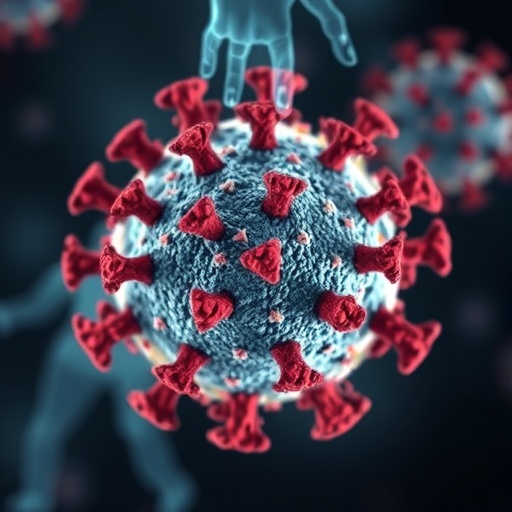In a significant stride toward combating the ongoing challenges posed by the SARS-CoV-2 virus and its continually emerging variants, a groundbreaking study has introduced a computational framework that not only anticipates viral evolution but also identifies broadly neutralizing antibodies (bnAbs) capable of countering both current and future strains. The innovative research, led by Jian, Wec, Feng, and colleagues, has leveraged advanced viral evolution prediction models alongside immunological insights, enabling the proactive development of antibody therapies that hold promise against an ever-shifting viral landscape.
The persistent global threat of COVID-19 has been exacerbated by the virus’s remarkable ability to mutate, resulting in multiple variants with increased transmissibility, immune evasion capabilities, and, in some cases, enhanced pathogenicity. Traditional approaches to therapeutic antibody development have largely been reactive, targeting existing virus variants after their emergence and spread. However, this new methodology represents a paradigm shift, enabling scientists to forecast viral mutational trajectories and preemptively identify antibodies with the flexibility to neutralize a broad spectrum of variants.
Central to the study’s success is the integration of molecular evolution models with high-throughput immunological data. The research team employed sophisticated algorithms that analyze patterns of viral mutation, structural constraints of the spike protein—the primary target of neutralizing antibodies—and the binding affinities of antibodies isolated from convalescent patients and vaccinated individuals. This multifaceted approach allowed the generation of predictive maps detailing probable future mutations and their likely impact on antibody recognition.
One of the most technically demanding aspects involved modeling the spike protein’s receptor-binding domain (RBD), which mediates viral entry into host cells. The RBD is the focal site of neutralizing antibody interactions and a hotspot for mutational change. Researchers utilized deep mutational scanning data combined with protein structural modeling to assess how prospective amino acid substitutions might influence both viral fitness and immune escape potential. This structural foresight was essential for pinpointing antibody epitopes less susceptible to mutational disruption.
The study’s antibody discovery pipeline further incorporated machine learning algorithms trained on existing neutralization datasets. These algorithms sifted through extensive antibody repertoires, identifying candidates with binding profiles consistent across multiple variants. By emphasizing antibodies that target conserved regions of the spike protein—regions evolutionary constrained due to functional necessity—the framework enhanced the likelihood that the selected bnAbs would retain efficacy even against as-yet-unseen variants.
Experimental validation played a pivotal role in confirming computational predictions. Candidate bnAbs identified through in silico screening underwent rigorous in vitro neutralization assays against panels of SARS-CoV-2 variants, including the notorious alpha, beta, delta, and omicron lineages. Results demonstrated potent neutralization across these variants, validating the predictive model’s accuracy. Remarkably, some antibodies displayed the capacity to neutralize viral pseudotypes engineered to express RBD mutations predicted to emerge in future viral strains.
In addition to neutralization potency, the research underscored the importance of antibody breadth and durability. The bnAbs selected exhibited not only robust neutralizing activity but also resistance to viral escape in serial in vitro passaging experiments designed to simulate potential evolutionary pressures. This durability stems from targeting conserved epitopes with limited mutational space, a strategy that reduces the virus’s ability to evade immune detection without incurring a fitness cost.
Furthermore, the study explored the implications for vaccine design. By mapping anticipated viral evolutionary paths, vaccine antigens can be optimized to present conserved epitopes favored by these bnAbs, thus priming the immune system more effectively against future variants. This forward-thinking approach complements current vaccine platforms by potentially extending protection durability and breadth, attenuating the need for frequent reformulations driven by new variants.
The research also opens avenues for therapeutic antibody cocktails tailored to preemptively mitigate immune escape. By combining bnAbs targeting distinct conserved epitopes, such cocktails could present a multifaceted barrier to viral escape mechanisms. The implementation of such combination therapies could enhance clinical outcomes for high-risk populations and serve as a frontline defense during variant-driven outbreaks.
From a computational biology perspective, the study exemplifies the power of integrating evolutionary theory, structural bioinformatics, and immunology. The viral evolution prediction framework developed sets a new standard for translational research, offering a template for addressing other rapidly evolving pathogens. By harnessing computational resources to model future molecular landscapes, the study underscores how predictive science can bolster pandemic preparedness and response efficacy.
Critically, the implications of this research are profound not only for SARS-CoV-2 but broadly for emerging infectious diseases characterized by high mutation rates. The adaptability of the computational pipeline to other viral families positions it as an invaluable tool in global health security, enabling early identification of bnAbs against pathogens before widespread transmission occurs.
In conclusion, the work by Jian, Wec, Feng, et al., published in Nature Microbiology, represents a quantum leap in antiviral antibody discovery. Combining predictive viral evolution with robust immunological validation charts a proactive course against SARS-CoV-2’s evolving threat. This approach not only accelerates therapeutic development timelines but also enhances the resilience of antibody-based interventions, promising a new era of anticipatory medicine in infectious disease control.
As we continue to grapple with the COVID-19 pandemic’s shifting dynamics, such innovations highlight the synergy between computational models and laboratory science. They underscore a future where the rapid evolution of pathogens does not outpace our ability to understand and neutralize them. Through foresight-driven strategies, the scientific community moves closer to durable, broadly effective countermeasures that can safeguard global health against viral threats both present and on the horizon.
Subject of Research: Viral evolution prediction and identification of broadly neutralizing antibodies against current and prospective SARS-CoV-2 variants.
Article Title: Viral evolution prediction identifies broadly neutralizing antibodies to existing and prospective SARS-CoV-2 variants.
Article References:
Jian, F., Wec, A.Z., Feng, L. et al. Viral evolution prediction identifies broadly neutralizing antibodies to existing and prospective SARS-CoV-2 variants. Nat Microbiol (2025). https://doi.org/10.1038/s41564-025-02030-7
Image Credits: AI Generated




